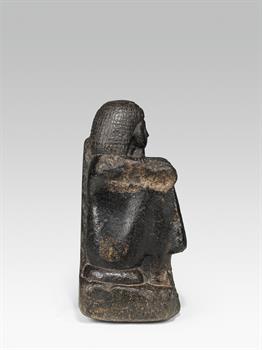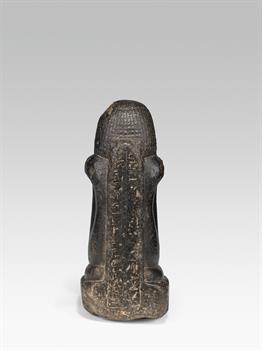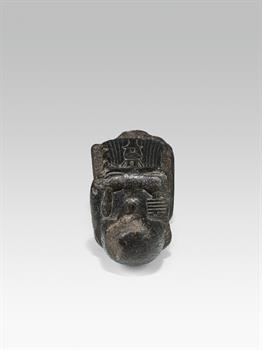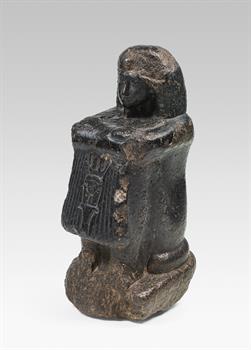1001
Egyptian statue "Block statue"
Egypt, Ramesside period (19th/20th dynasty, 1295–1069 B.C.)
granite diorite; visible signs of ageing on forehead and elbow; imperfection on frontal part of base
h. 40.5 cm; 17.2 x 20 cm (base)
Provenance
since c. 1900 in private property, Vienna
Estimate: € 25.000 - 50.000
Auction is closed.
A statue that derives its name “Block statue”, due to its typical cubical shape and mostly sitting male figure depictions, follows an Egyptian statue type known from the Middle Kingdom period (2000 B.C.) till the Greek-Roman era. Over 350 known examples embody, in variable forms, one of the inner drives of Egyptian art to contain the human figure into the cubical, abstract basic form.
Whilst “Block statues”, especially from the Middle Kingdom and again in the late Egyptian period, show a nearly complete stereometric cubic form, this sculpture embodies with its carved-out bodily details a clearly more vivid sitting figure.
The legs of the on a round base sitting figure are held close to the body, the arms folded over the knees. The curly wigged head is elevated with a short neck base with beard over a cubic, but vivid modelled bodily structure. The expressive eyes are on the sides of a straight, pointy nose. The typical laughing smile of the that period is only barely visible.
In his hands the sitting figure holds two typical Egyptian symbols for eternity, continuance, and fertility. In his left hand he holds the Djed, which as symbol for Osiris spine, symbolises infinity and continuance. In his right hand he holds a lettuce plant, a common symbol for fertility in most Block statues.
On the slightly outward-arched apron below the arms, the symbol of the goddess Hathor is engraved in the shape of a Sistrum: placed between the beam-shaped papyrus bundles, symbolising the density of papyrus, emerging from the papyrus flower is the face of the goddess Hathor with the cow-ears, goddess of love, music, and dance. On top of the wig hanging down both sides of her face – notice the cow-ears of the in cow-form depicted goddess – stands a little pavilion, which is flanked by two curved lines. These details together are forming the Sistrum, the classical instrument of Hathor: the papyrus flowers as the holding rod, Hathor’s face with the pavilion forming the sound body with rattle sticks.
Based on this depiction the sculpture shows close resemblance to the common type of the Naophores, where the sitting figure holds a small shrine in the front, and where Hathor is also vividly depicted.
On the back the name of the statue owner, his title, and sacrificial prayers are engraved in an obelisk-like pointed pillar, although heavily worn. Most statues in this style were originally on display in temples, only rarely in graves. It was vital for the depicted dignitaries – a priest or important civil servant – to at least have their presence represented by a statue within their ceremonies, and to have it take part in the prayers and processions in their stead.
The sculpture has minor imperfections on several places: the forehead and the elbows have minor damages. The front part of the base has a flaw, because of which only a part of the sandaled feet remain.
A Block statue very similar to this, be it smaller and in perfect condition, is the Block statue of Hor from the Louvre, also Ramesside period.






